Class Mammalia
Order Lagomorpha
Family Leporidae
Sylvilagus—Systematics and Identification // Sylvilagus sp.—Cottontails // Sylvilagus audubonii—Desert Cottontail // Sylvilagus bachmani—Brush Rabbit // Sylvilagus floridanus—Eastern Cottontail // Sylvilagus hibbardi—Hibbard's Cottontail // Sylvilagus nuttallii—Mountain Cottontail // Sylvilagus robustus—Davis Mountains Cottontail
Rabbits are prime prey for a number of large raptorial birds and medium-sized mammalian predators, including foxes, Coyotes, and Bobcats. As such, they tend to be common in cave faunas, where they presumably have been brought in by predators or have fallen into the pit-trap cave.
For taxonomic comments, techniques of discrimination between species, and lists of sites shown to have occurrences of taxa by the strongest of the techniques, see the Sylvilagus account. A number of specimens can be assigned to a pair of species, such as S. floridanus/nuttallii; after some hesitation, the decision has been made to omit these from the Sylvilagus accounts.
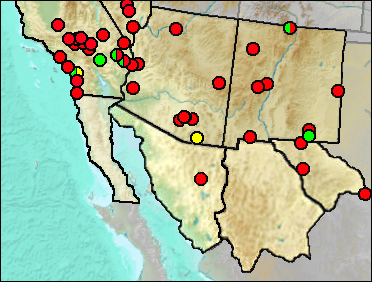
Post-cranial material is unidentifiable to species under current knowledge as frequently are fragmentary skull parts.
Sites.
Late Blancan: California Wash (Johnson et al. 1975).
Late Blancan/Early Irvingtonian: Elsinore: Mimomys (Pajak et al. 1996).
Irvingtonian: Elsinore: Microtus/Mammuthus (Pajak et al. 1996).
Early Irvingtonian: Gypsum Ridge (Wagner and Prothero 2001).
Medial Irvingtonian: SAM Cave (Rogers et al. 2000); Slaughter Canyon Cave (Morgan and Harris 2015).
Late Irvingtonian: Elsinore: Pauba Formation (Pajak et al. 1996).
Irvingtonian/Rancholabrean: Archer (Jefferson 2014); Cadiz (Jefferson 2014).
Rancholabrean: Bitter Springs Playa (Jefferson 2014); Centennial Parkway, Las Vegas Valley (Jefferson et al. 2015); Century City, Los Angeles (Jefferson 1991b); Clay Mine Road (Jefferson 2014); Cool Water Coal Gasification Site (Jefferson 1991b); Detention Basin, Upper Las Vegas Wash (Jefferson et al. 2015); Eagle Crest (Jefferson 2014); Edwards Air Force Base (Jefferson 2014); Hawes (Jefferson 2014); Hoffman Road (Jefferson 2014); Kramer (Jefferson 1991b: ? gen.); Los Angeles Police Station (Jefferson 1991b); National City West (Jefferson 2014); Piute Ponds (Jefferson 2014); Piute Valley (Jefferson 1991b); Silver Lake (Jefferson 1991b); Tule Springs 1 (Jefferson et al. 2015); Tule Springs 4 (Jefferson et al. 2015).
Rancholabrean/Early Holocene: Metro Rail Universal City Station (Jefferson 2014).
Late Pleistocene: Wanis View (Jefferson 2014).
Sangamon: Bonito Creek (Jefferson 1991b); Naval Fuel Reserve Quarry (Jefferson 1991b); Naval Housing Unit (Jefferson 1991b).
Wisconsin: Glen Abbey (Majors 1993); White Lake (Morgan et al. 2009).
Early/Early-Mid Wisconsin: New Area, Dry Cave (Harris 1993c).
Mid Wisconsin: CC:5:2 (Meade et al. 2003); Térapa (Mead et al. 2006: cf. gen.).
Mid/Late Wisconsin: Pintwater Cave (Hockett 2000); Rampart Cave (Lindsay and Tessman 1947); Screaming Neotoma Cave (Glennon 1994); Tsuma Properties, San Clemente (Jefferson 2014).
Late Wisconsin: Artillery Mountains C (Van Devender and King 1971); Arroyo de las Tinajas 7B (UTEP); Arroyo de las Tinajas 7A (UTEP); Bat Cave (Harris 1993c); Bennett Ranch #1 (Van Devender and Bradley 1990); Blackwater Draw (Morgan and Lucas 2005); Cueva Quebrada (Lundelius 1984); Ernst Tinaja #2A (Van Devender and Bradley 1990); Falling Arches (Jefferson 1991b); La Mirada (Jefferson 1991b); Lower Sloth Cave (Logan 1983); Murray Springs (Mead et al. 2005); Rick's Cenote (UTEP); New Water Mountains (Mead et al. 2005); Skull Cave (Emslie 1988); South Crest Midden, Sheep Range (Jefferson et al. 2015); Tucson Mountains (Mead et al. 2005); Tunnel Ridge Midden (Jefferson 1991b); Upper Sloth Cave (Logan and Black 1979); Vulture Canyon (Van Devender et al. 1977a); Wolcott Peak (Mead et al. 2005.
Late Wisconsin/Holocene: Baldy Peak Cave (Harris 1993c); Beyond Bison Chamber (Harris 1970a); Blackwater Loc. No. 1 (Morgan and Lucas 2005); Calico Lakes (Jefferson 1991b); Deadman Cave (Mead et al. 1984; Luz Foundation (Jefferson 1991b); Luz Solar Trough (Jefferson 1991b); SAM Cave (Rogers et al. 2000); Schuiling Cave (Jefferson 1991b); Sheep Camp Shelter (Harris 1993c); Solar One (Jefferson 1991b); Tule Springs (Mawby 1967).
Literature. Emslie 1988; Frey 2004; Glennon 1994; Harris 1970a, 1993c; Hockett 2000; Jefferson 1991b, 2014; Jefferson et al. 2015; Johnson et al. 1975; Lindsay and Tessman 1974; Logan 1983; Logan and Black 1979; Lundelius 1984; Majors 1993; Mawby 1967 ; Mead et al. 1984; Mead et al. 2003; Mead et al. 2005; Morgan and Harris 2015; Morgan and Lucas 2005; Morgan et al. 2009; Pajak et al. 1996; Rogers et al. 2000; Ruedas 1998; Van Devender and Bradley 1990; Van Devender and King 1971; Van Devender et al. 1977a; Wagner and Prothero 2001.
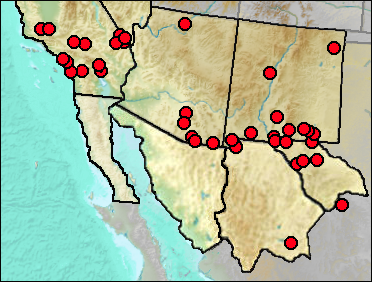
Sylvilagus audubonii is the common cottontail throughout the region at lower elevations, extending in places up into the lower Piñon-Juniper zone. In common with a number of mammals adapted to arid and semi-arid habitats, it has relatively large auditory bullae. Teeth tend to be relatively complex, with thicken enamel and thick deposits of cementum, presumably responses to relatively harsh desert vegetation.
East of the Guadalupe Mountains, Desert Cottontails appear to have been present in the Early/Early-Mid and mid Wisconsin, but to have been replaced entirely during full glacial times by S. nuttallii. They reappear toward the end of the Wisconsin. At U-Bar Cave, far to the west, they are identified from mid Wisconsin deposits through full-glacial times, though S. nuttallii also occurred. Most other late sites showing S. audubonii are known to contain mixed late Wisconsin/Holocene elements, making it difficulty to determine contemporaneity of S. audubonii with other species.
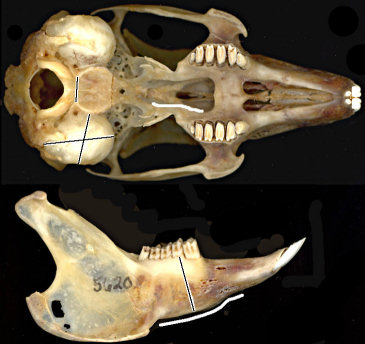
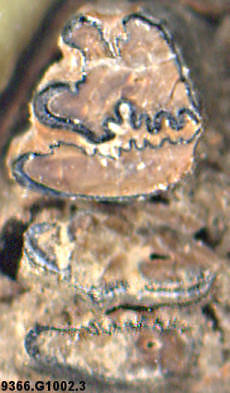
Fig. 1 (left). Skull and dentary of Sylvilagus audubonii denoting characters useful in discrimination. Characters are slight constriction and ridge on interpterygoid fossa, basioccipital constriction, bulla size, and depth of dentary.
Fig. 2 (right). Lower left p3 and p4 of fossil Sylvilagus audubonii from Pendejo Cave, showing typical tooth patterns.
Sites.
Rancholabrean: Alkali Flat (Morgan and Lucas 2005: cf.); Anthony Gap Cave (UTEP); Bedford Properties (Jefferson 1991b); Cool Water Coal Gasification Solid Waste Site (Jefferson 1991b); Papago Springs Cave (Czaplewski and Mead et al. (1999: cf.); Park La Brea A (Jefferson 2014); Tramperos Creek (Morgan and Lucas 2005: ?).
Rancholabrean/?Early Holocene: Mitchell Caverns (Jefferson 1991b: cf.).
Sangamon: Newport Bay Mesa (Jefferson 1991b cf.).
Wisconsin: Big Manhole Cave (Harris 1993c); Costeau Pit (Jefferson 1991b).
Early/Early-Mid Wisconsin: Lost Valley (Harris 1993c: cf.; UTEP ?); Rm Vanishing Floor (Harris 1993c); Sabertooth Camel Maze (Harris 1993c).
Mid Wisconsin: Baby Vulture Den #5B(1) (Van Devender and Bradley 1990: cf.); Devil Peak (Jefferson et al. 2015); McKittrick (Schultz 1937); Navar Ranch (Van Devender et al. 1987: cf.); Papago Springs Cave (Czaplewski and Mead et al. 1999: cf.; Skinner 1942); Pendejo Cave (Harris 2003); Tank Trap Wash (Van Devender et al. 1987: cf.); Tunnel View #6 (Van Devender and Bradley 1990: cf.); U-Bar Cave (UTEP).
Mid/Late Wisconsin: Animal Fair, Grid D (UTEP); Dark Canyon Cave (Tebedge 1988); Diamond Valley (Springer et al. 2009); Pit N&W Animal Fair (Harris 1993c); Rancho La Brea (Stock and Harris 1992).
Mid/Late Wisconsin/Holocene: Jimenez Cave (Messing 1986); Sierra Diablo Cave (UTEP).
Mid Wisconsin-Holocene: Shelter Cave (UTEP).
Late Wisconsin: Algerita Blossom Cave (Harris 1993c); Antelope Cave (Reynolds, Reynolds, Bell, and Pitzer 1991: cf.); Ernst Tinaja #2B(2) (Van Devender and Bradley 1990: cf.); Lehner Ranch (Mead et al. 2005); Maricopa (Jefferson 1991b): Mountain View Country view (Jefferson 2014: cf.); Pendejo Cave (Harris 2003); Picacho Peak (Van Devender et al. 1991: cf.); Pyeatt Cave (Mead et al. 2005); Quitman Mountains (Van Devender and Bradley 1990: cf.); Stalag 17 (Harris 1993c); Stanton's Cave (Olsen and Olsen 1984: cf.); TT II (Harris 1993c: cf.); U-Bar Cave 13-14 ka (Harris 1989); U-Bar Cave 14-15 ka (Harris 1989); U-Bar Cave 15-18 ka (Harris 1989); U-Bar Cave 18-20 ka (Harris 1989).
Late Wisconsin/Holocene: Balcony Room (Harris 1993c); Boyd's Cave (UTEP); Burnet Cave (Schultz and Howard 1935: cf.); Conkling Cavern (Harris 1993c); Baldy Peak Cave (UTEP); Fowlkes Cave (Dalquest and Stangl 1984); Isleta Cave No. 1 (Harris 1993c); Isleta Cave No. 2 (Harris 1993c); Howell's Ridge Cave (Harris 1993c); Kokoweef Cave (Reynolds, Reynolds, et al. 1991: cf.); Newberry Cave (Jefferson 1991b); Pendejo Cave (Harris 2003); Williams Cave (Ayer 1936: cf.; confirmed by A. H. Harris).
Literature. Ayer 1936; Czaplewski and Mead et al. 1999; Dalquest and Stangl 1984; Harris 1989, 1993c, 2003; Jefferson 1991b, 2014; Jefferson et al. 2015; Mead et al. 2005; Messing 1986; Morgan and Lucas 2005; Olsen and Olsen 1984; Reynolds, Reynolds, et al. 1991; Reynolds, Reynolds, Bell, and Pitzer 1991; Schultz 1937; Schultz and Howard 1935; Skinner 1942; Springer et al. 2009; Stock and Harris 1992; Tebedge 1988; Van Devender and Bradley 1990; Van Devender et al. 1987; Van Devender et al. 1991.
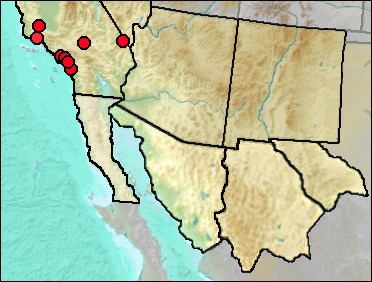
The current distribution is confined to the West Coast region from the Columbian River south through the Baja Peninsula and to the eastern slopes of the Sierra Nevada (Chapman 1974).
Sites.
?Irvingtonian/Rancholabrean: Emery Borrow Pit (Jefferson 1991b).
Rancholabrean: Cool Water Coal Gasification Solid Waste Site (Jefferson 1991b).
Sangamon: Newport Bay Mesa (Jefferson 1991b); San Pedro Lumber Co. (Jefferson 1991b: cf.).
Wisconsin: Carpinteria (Wilson 1933); Costeau Pit (Jefferson 1991b).
Mid Wisconsin: McKittrick (Schultz 1937); Pacific City (Wake and Roeder 2009: cf.).
Mid/Late Wisconsin: Rancho La Brea (Stock and Harris 1992).
Late Wisconsin: Antelope Cave (Reynolds, Reynolds, Bell, and Pitzer 1991: ?).
Literature. Chapman 1974; Jefferson 1991b; Reynolds, Reynolds, Bell, and Pitzer 1991; Schultz 1937; Stock and Harris 1992; Wake and Roeder 2009; Wilson 1933.
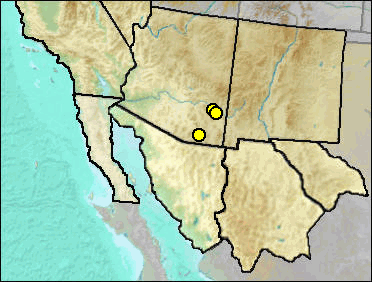
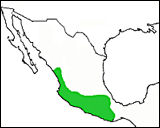
Fig. 1. Current distribution of Sylvilagus cunicularius. The distribution map is adapted from Cervantes et al. (1992).
White (1991) tentatively assigned several Blancan specimens to the extant species based on size and folding of the posterior wall of the posterior, external reentrant of p3. Sylvilagus cunicularius is a large cottontail whose present distribution is well south in Mexico (Fig. 1).
Sites.
Late Blancan: 111 Ranch (Morgan and White 2005); Curtis Ranch (White 1991: cf.; Morgan and White 2005: ?); San Simon Fauna (White 1991: cf.).
Literature. Cervantes et al. 1992; Morgan and White 2005; White 1991.
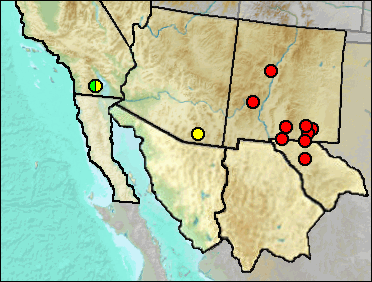
In montane areas, S. floridanus (S. cognatus, S. holzneri) tends to inhabit brushy areas of good cover. In the Great Plains, including parts of eastern New Mexico, grassland is inhabited.
As mentioned in the generic account, S. cognatus and/or S. holzneri may be present, subsumed by the name S. floridanus.
The specimen from Isleta Cave No. 1 reported by Harris and Findley (1964) has been reexamined and appears to almost certainly be Holocene, preserving some soft tissue. A second specimen could be either late Wisconsin or Holocene. The situation with Isleta Cave No. 2 appears similar. Presence may indicate an influx of eastern grassland forms during the early Holocene. Occurrence during the Early/Early-Mid Wisconsin likewise may indicate grassland influence such as now found on the western edge of the Great Plains somewhat farther north (Harris 1988).
Fig. 1. Left dentary of Sylvilagus floridanus from Mystery Light Cave.
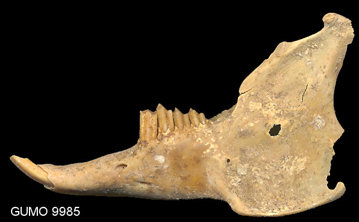
Sites.
Late Blancan: Curtis Ranch (Morgan and White 2005: ?).
Irvingtonian: Anza-Borrego (Murray 2008: cf.).
Rancholabrean: Palomas Creek Cave (Harris 1993c: cf.).
Early/Early-Mid Wisconsin: Lost Valley (Harris 1993c: cf.).
Mid Wisconsin: Pendejo Cave (Harris 2003); Tank Trap Wash (Van Devender et al. 1987: cf.); Tunnel View (Van Devender and Bradley 1990: cf.).
Mid/Late Wisconsin/Holocene: Sierra Diablo Cave (UTEP).
Late Wisconsin: Camel Room (Harris 1993c: ?); Muskox Cave (Logan 1981: cf.); Mystery Light Cave (this volume).
Late Wisconsin/Holocene: Balcony Room (UTEP); Burnet Cave (Schultz and Howard 1935); Isleta Cave No. 1 (UTEP: cf.); Isleta Cave No. 2 (Harris 1993c; UTEP); Pendejo Cave (Harris 2003);
Emendations: Specimens earlier recorded from Stalag 17 (Harris 1993c) as "S. ? floridanus" have been re-identified as S. audubonii, removing the taxon from that site.
Withdrawn.
Late Wisconsin/Holocene: U-Bar Cave (Harris 1993c: ?).
Literature. Harris 1988, 1993c, 2003; Logan 1981; Morgan and White 2005; Murray 2008; Schultz and Howard 1935; Van Devender and Bradley 1990; Van Devender et al. 1987.
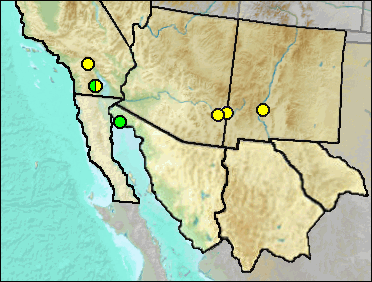
Similar in size to S. floridanus, this Blancan to Irvingtonian taxon differs from other Sylvilagus in that the posterior reentrant angle of p/3 is rounded in its inner portion and does not reach the lingual border (White 1991).
Late Blancan: Caballo (Morgan et al. 2011: ?); Jack Rabbit Trail, San Timoteo Badlands (Albright 2000); San Simon Fauna (Morgan and White 2005); Virden (Morgan et al. 2008: cf.).
Late Blancan/Irvingtonian: Anza-Borrego (Murray 2008).
Irvingtonian: El Golfo (Croxen et al. 2007).
Literature. Albright 2000; Croxen et al. 2007; Morgan et al. 2008, 2011; Murray 2008; White 1991.

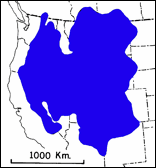
Fig. 1. Current distribution of Nuttall's Cottontail. Figure adapted from Chapman (1975).
In New Mexico, this is largely a cottontail of woodland and coniferous forest; farther north, however, it is common in sagebrush habitat.
This is the common cottontail of the regional late Wisconsin-age deposits in the eastern portions of the region. At times, as in the late mid-Wisconsin of Dry Cave and throughout the mid Wisconsin deposits of U-Bar Cave, it occurs with S. audubonii. Currently, it occurs in parapatry with S. audubonii (and S. floridanus) in Colorado, separated only by microhabitat preferences (Armstrong 1972). The fossil co-occurrences may indicate a similar situation, with S. nuttallii inhabiting forest edge or relatively dense brush and S. audubonii in more open habitat.
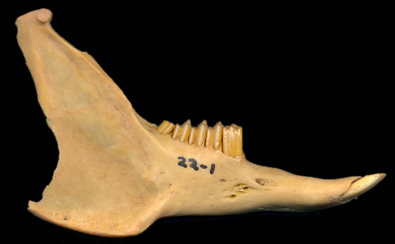
Fig. 1. Right dentary of S. nuttallii from sediments pre-dating Wisconsin pleniglacial deposits of the Animal Fair site. Note the relatively slight depth of the dentary below the tooth row compared to the depth in S. audubonii (Fig. 1, S. audubonii account, above).
Sites.
Early/Early-Mid Wisconsin: Lost Valley (Harris 1993c); Rm Vanishing Floor (Harris 1993c); Sabertooth Camel Maze (Harris 1993c: cf.).
Mid Wisconsin: Pendejo Cave (Harris 2003); U-Bar Cave (Harris 1987).
Mid/Late Wisconsin: Dark Canyon Cave (Harris 1993c); Hampton Court (Harris 1993c); Pit N&W Animal Fair (Harris 1993c).
Mid/Late Wisconsin/Holocene: Sierra Diablo Cave (UTEP: cf.).
Late Wisconsin: Algerita Blossom Cave (Harris 1993c); Animal Fair 18-20 ka (Harris 1989); Balcony Room (UTEP); Big Manhole Cave (Harris 1993c); Bison Chamber (Harris 1970a); Camel Room (Harris 1993c); Charlies Parlor (Harris 1989); Circus Route (Harris 1993c); Dust Cave (Harris and Hearst 2012); Harris' Pocket (Harris 1970a); Human Corridor (Harris 1993c); Marmot Cave (Thompson and Morgan 2001); Muskox Cave (Logan 1981: cf.); Sandia Cave (Thompson and Morgan 2001); Stalag 17 (Harris 1993c); TT II (Harris 1993c); U-Bar Cave 14-15 ka (Harris 1989); U-Bar Cave 15-18 ka (Harris 1989).
Late Wisconsin/Holocene: Boyd's Cave (Harris 1993c); Burnet Cave (Harris 1993c); Conkling Cavern (Harris 1993c); Howell's Ridge Cave (Harris 1993c); Isleta Cave No. 1 (UTEP: cf.); Isleta Cave No. 2 (UTEP); Pendejo Cave (Harris 2003).
Literature. Armstrong 1972; Harris 1970a, 1987, 1989, 1993c, 2003; Harris and Hearst 2012; Logan 1981; Thompson and Morgan 2001.
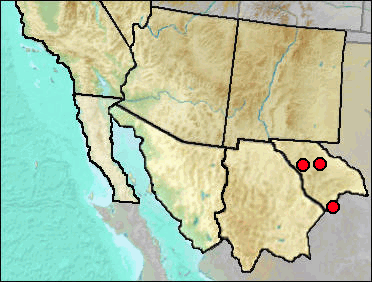
Dalquest and Stangl (1984) indicate that their single specimen from Fowlkes Cave is similar to S. floridanus robustus, generally considered a species separate from S. floridanus (Ruedas 1998). However, Nalls et al. (2012) suggest that both genetic and morphological differences from S. floridanus are so weak as be inconsistent with recognition of S. robustus as a species separate from S. floridanus. Van Devender and Bradley (1990) based their tentative identification on size.
Sites.
Mid Wisconsin: Tunnel View #8A(2) (Van Devender and Bradley 1990: cf.).
Late Wisconsin: Bennett Ranch #5 (Van Devender and Bradley 1990: cf.).
Late Wisconsin/Holocene: Fowlkes Cave (Dalquest and Stangl 1984).
Literature. Dalquest and Stangl 1984b; Nalls et al. 2012; Ruedas 1998; Van Devender and Bradley 1990.
Last Update: 4 Feb 2016